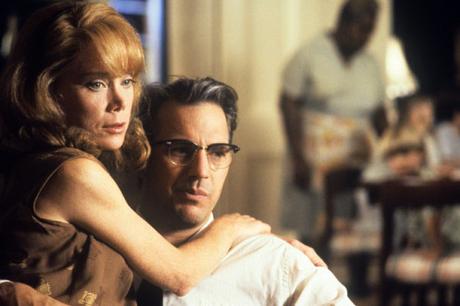 Liz (Cissy Spacek) & Jim Garrison (Kevin Costner) in their living room, in JFK (1991)
Liz (Cissy Spacek) & Jim Garrison (Kevin Costner) in their living room, in JFK (1991)Quo Vadis, Domine?”
Liz Garrison (Cissy Spacek), District Attorney Jim Garrison’s devoted and long-suffering spouse, begins to feel the negative effects of the adverse publicity heaped on her husband’s investigation into Kennedy’s death.
“You care more about John Kennedy than your own family!” she tearfully confides. With good reason, Liz knows that as the wife of a fact-finding D.A., she will be in for a grueling endurance test of missed family gatherings and empty chairs at Easter Sunday luncheons.
As a counter to Garrison’s accusations, Clay Shaw mounts a campaign against the ensuing investigation into his alleged involvement in JFK’s death. Almost immediately, scandal erupts over Garrison’s use of public funds to pay for his office’s inquiries.
In the meantime, David Ferrie (the fellow with the painted-on eyebrows and ill-fitting blond wig) freaks out in a paranoid screed, lashing out at the U.S. Government, the Mob, the Cubans, anybody and everybody he can think of.
“I’m a dead man!” Ferrie blurts out, in a steady, X-rated stream-of-consciousness rant directed at the D.A. and his two assistants Bill and Lou, in relation to Lee Harvey Oswald and Jack Ruby, among others — none of which make a bit of sense. It’s the ravings of a lunatic.
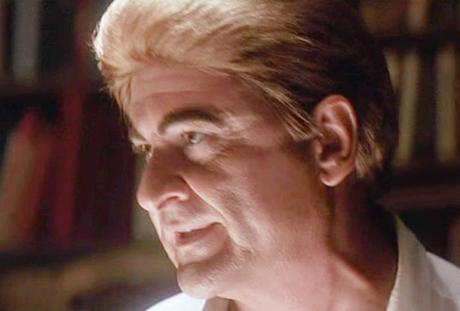
The attorneys meet again, behind closed doors of course, where they size up Ferrie’s actions and “arguments” as untenable to their cause. Office assistant Numa Bertel (Wayne Knight) bursts in on the meeting to notify Garrison that they’ve been bugged. This explains how the press is always aware of their every move, what they say, where they go, and who they plan to use to mount their case. In a dramatic moment, the fatal phone call comes in that Ferrie is dead.
In a search of the deceased’s ransacked apartment, evidence of thyroid medication is found (too much of it, in fact, indicating foul play); and then, just as dramatically, Assistant D.A. Susie Cox enters to announce that Ferrie’s Cuban associate, Eladio del Valle, has also met with foul play: he’s been hacked to death. Suspicious deaths begin to pile up, more than you can shake a fist at. Outside the office, someone (perchance an FBI informant?) approaches another assistant, Bill Broussard, to get him to switch his allegiance to the other side. Bill is the previously mentioned Judas Iscariot figure, and he’s about to get plucked.
Amid all the turmoil, Garrison decides to go to Washington, D.C., to meet with “X” (Donald Sutherland), who tells him somewhat surreptitiously a lot more than the District Attorney (or anyone else, for that matter) should “know” about Oswald, Kennedy, and a whole host of other names; about “X” being reassigned to the North Pole to get him out of the way, while two weeks later the president was shot to death. Right on cue, we are shown a snippet of Abraham Zapruder’s 8mm film, along with obviously fake archival footage.
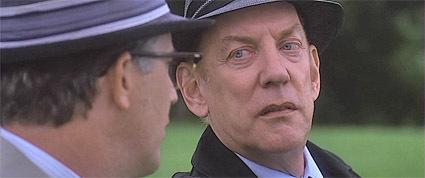
“X” makes his case, and then summarizes his findings by posing the following questions: Ruby, Oswald, Cuba and such were nothing more than red herrings, dupes and pawns of a much bigger, much more insidious plot. He counts them off one by one: “Why was Kennedy killed? Who benefitted? Who has the power to cover it up? Who?”
He answers his own queries: The generals, the so-called military-industrial complex that Eisenhower, in the beginning of the film and at the end of his two terms as president, warned against. “The call is made, the contract is put out. No one said, ‘He must die.’ No vote. Nothing’s on paper. There’s no one to blame. It’s as old as the crucifixion. Or the military firing squad …”
After JFK’s death, LBJ signs a document, National Security Action Memorandum No. 273. “Just get me elected,” comments an actor made up to look like President Johnson, “I’ll give you your damn war.” Crisis, betrayal, murder, retribution. Listening to this, Garrison is in shock and disbelief at these revelations. How can he find the will to go on? He’s St. Peter leaving Rome to the Romans (remember, he’s in D.C. at the moment, our modern-day Roma). “X” urges him on, and coaxes Garrison to do what’s right. He charges the D.A. to “Stir the shit storm.” The hope is to start a chain reaction of people coming forward. Then the government will crack.
“The truth is on your side, bubba. I just hope you get a break.” With the Washington Monument and the symbolic dome of the Capitol Building in the background (a nice analogy to the dome of St. Peter’s Basilica in Vatican City), the mysterious “X” walks off into the distance and in the direction of those very monuments.
At this crucial juncture, “X” becomes Christ returning to Rome. In one of the excluded books of the Apocrypha, known as the Acts of Peter, tradition dictates that Saint Peter had seen a vision of Our Lord, Jesus Christ, walking in the direction of the Eternal City, back to where Peter had just left to escape possible torture and death.
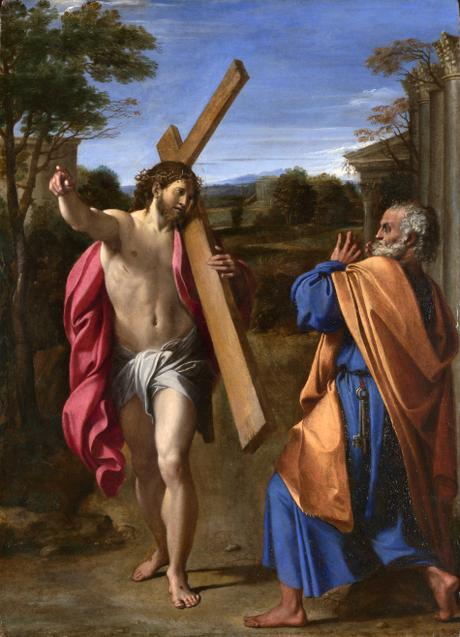
“Quo vadis, Domine?” — “Whither thou goest, Lord?” Peter asked of Christ. And Christ answered him: “I am going to Rome to be crucified all over again.” At that, Peter turned swiftly around and, with his life in jeopardy, took up Christ’s challenge and returned to the city en route to becoming a martyr to the cause.
Garrison remains seated. He is alone on the bench. We next see him at President Kennedy’s gravesite, with the eternal flame burning in the foreground. He is deep in thought, pondering what his next move will be.
As he gazes wistfully at the flame, an older African American gentleman appears alongside him, with his young grandson in hand. All of a sudden, Garrison’s downcast expression changes into a newfound determination to arrest Clay Shaw for conspiracy and acting with others to commit the murder of President John F. Kennedy.
Dramatic music is cued up.
Logic is the Beginning of Wisdom
Switching gears, we find Chief Justice Earl Warren (shot from below so as to give his immense height its full quotient) as he speaks to a reporter. Warren dismisses the charge against Shaw as spurious, claiming it is not credible.
Back in “Big Easy” New Orleans (and back down to Earth), Garrison responds to journalists’ queries about Justice Warren’s comment. Garrison mounts the steps and overlooks the mob of newshounds. He has taken up Christ’s cause and, by default, His cross. And who should be by his side? Why, his Judas, of course, in the person of discredited Assistant D.A. Bill Broussard. He will betray Garrison and his team, just as Christ was, for their seeking out of the truth.
“And what is truth?” Garrison poses, as Pilate had done to Jesus — a more or less rhetorical query to which no answer is proffered or expected. “It’s become a dangerous country,” he continues, “when you cannot trust anyone, anymore; when you cannot tell the truth. I say let justice be done, though the heavens fall!”
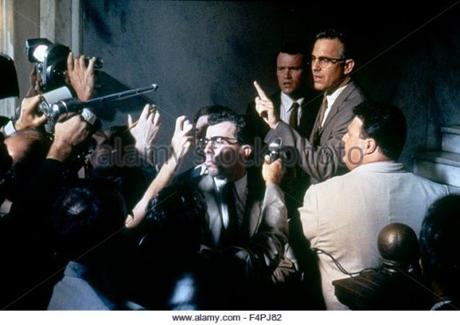
He might as well have spoken Julius Caesar’s famous aside, “Let the die be cast,” as he crossed the Rubicon River with his army into Rome. For both men, there was no turning back.
There are angry recriminations from Garrison’s wife Liz. Domestic problems continue to resurface and intrude on matters going forward. The attorneys meet yet again to discuss the avenues they need to take with regard to Oswald. After throwing theories and suppositions hither and yon — in particular, one about the “missing” FBI telex, warning their office of a possible assassination attempt on November 22 — Judas rises to his feet in the FBI’s defense. This leads to the other assistant D.A., Lou, to resign on the spot.
Using unmistakable language that clearly identifies the group as Apostles, Broussard tosses out his personal credo: “How the hell you gonna keep a conspiracy going on between the Mob, CIA, FBI, Army Intelligence and who the hell knows what …. When you know for a fact [that] you can’t keep a secret in this room between 12 people? We got leaks everywhere!” The deadly germ of David Ferrie’s paranoia has infected one of their own.
Broussard can’t believe the government (or Church, or other established institution) can be responsible for such a heinous act. He’d rather believe the Mob is capable of carrying out the crime, but not our government. Garrison proceeds to tear his theory apart, even bringing up the idea of LBJ as a conspirator. As critic Gerardo Valero aptly put it, in a June 2012 article “Should JFK Have Even Been Made?” on the Roger Ebert website, “Perhaps it was hard for a man like [journalist and anchorman Walter] Cronkite [and, by implication, the average viewer] to consider the possibility that such nefarious acts (and their cover up) came from respectable sources.”
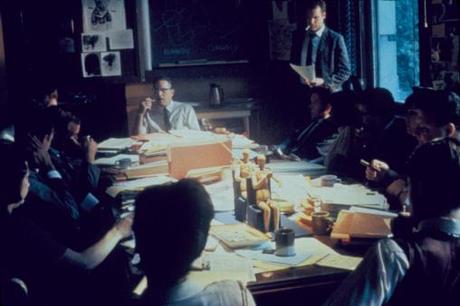
“All it takes is one Judas. People on the inside.” The analogies are apparent. From here on, the Apostles will be faced with an insurmountable brick wall of a flimsy case. In history, Garrison’s theories collapsed like a house of cards. Much of what was presented in court turned out to be half-baked, crackpot theories that led nowhere. Basically, Garrison had his people running down bogus leads which made them run in ever-widening circles.
The remainder of the film tries to come together, to tie all of these disparate elements into a coherent bow — or as coherent as possible in a kangaroo court-like atmosphere.
(End of Part Four)
To be continued…
Copyright © 2017 by Josmar F. Lopes
Advertisements
